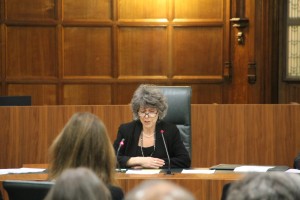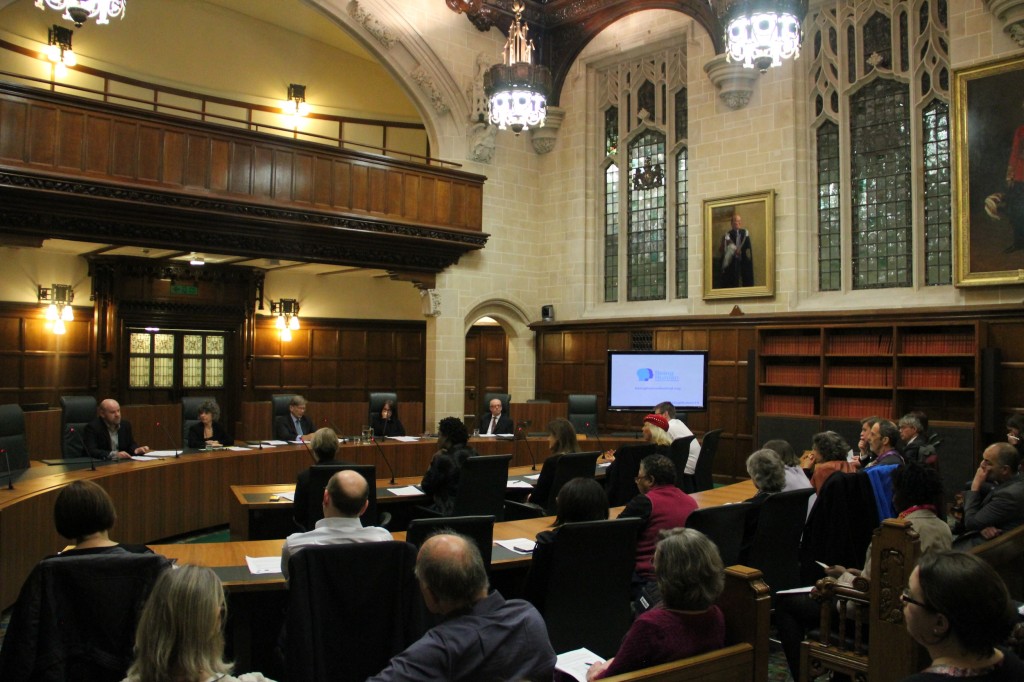In Ian McEwan’s The Children Act published this year, the author deftly weaves together the personal and professional lives of a High Court Judge in the family division, the fictional Fiona Maye.
His tale is rooted in the reality of law and judging: the judgments of his friend the former Court of Appeal judge Sir Alan Ward, who, McEwan describes in the Guardian, once went to a football match with a young boy who had previously been the subject of a court hearing following his refusal (supported by his parents) of a lifesaving blood transfusion.
This football match anecdote, which exposes the human side of the judge, was one of several recounted by Professor Erika Rackley, Birmingham Law School, at Wednesday’s event at the UK Supreme Court, in her contribution to the evening’s theme: ‘The Humanity of Judging‘.
The event was part of the first national festival of the humanities, the Being Human Festival, led by the School of Advanced Study, University of London, in partnership with the Arts & Humanities Research Council and the British Academy.
The Institute of Advanced Legal Studies (IALS) had been asked to devise a legally themed event to fit into the programme (it also gave tours of its roof-top bee hives, in the ‘Bee-ing Human‘ event on 21 November).
We approached the UK Supreme Court, whose communications director, Ben Wilson, responded enthusiastically and helped us plan an event which would bring together legal humanities and social research with a public audience.
The court already offers guided tours of the court for a small fee (details here) but this event offered a free tour, followed by a discussion chaired by Lord Carnwath, Justice of the UK Supreme Court and chair of the Advisory Council of the IALS.
The event took place on Wednesday evening (19 November) and gave attendees an insight into the origin and history of the court, which opened in 2009 in the renovated Middlesex Guildhall. The audience then gathered in Courtroom One to hear from our panel of experts.
Although the purpose of the event was to bring the public in touch with academic research, it would have seemed odd not to hear from a judge. So the discussion began, with a lively and engaging presentation by a deputy High Court judge from an unusual professional background: as a solicitor, not a barrister.
 Alexandra Marks drew from her personal perspective as a commercial lawyer who has made the transition to various judicial roles (in the Crown Court, County Court and High Court), as well as her two Commissioner roles (as Judicial Appointments Commissioner and Criminal Cases Review Commissioner), and long experience as a charitable trustee of organisations such as Amnesty International, JUSTICE and Prisoners Education Trust. In particular, Marks raised the issue of emotion and the ways in which judges engaged with their cases:
Alexandra Marks drew from her personal perspective as a commercial lawyer who has made the transition to various judicial roles (in the Crown Court, County Court and High Court), as well as her two Commissioner roles (as Judicial Appointments Commissioner and Criminal Cases Review Commissioner), and long experience as a charitable trustee of organisations such as Amnesty International, JUSTICE and Prisoners Education Trust. In particular, Marks raised the issue of emotion and the ways in which judges engaged with their cases:
Refreshing honesty of Deputy High Court Judge Alexandra Marks on emotional work of judging #beinghuman14
— Clare McGlynn (@McGlynnClare) November 19, 2014
We then heard from Dr Lawrence McNamara, deputy director and senior research fellow at the Bingham Centre for the Rule of Law; as part of a research project at the University of Reading from 2009-13 he interviewed a number of judges who had presided over terrorism trials (it was the first time that British judges had participated in such research).
 McNamara discussed first his own encounters with judgments and judges in Australia, noting that that humanity of judging is accompanied by the enormity of judging. Judges make decisions about the law and its consequences that will have profound effects on the lives of individuals and communities. At the same time, he said, we want our judges to be both human and engaged, yet fair and impartial.
McNamara discussed first his own encounters with judgments and judges in Australia, noting that that humanity of judging is accompanied by the enormity of judging. Judges make decisions about the law and its consequences that will have profound effects on the lives of individuals and communities. At the same time, he said, we want our judges to be both human and engaged, yet fair and impartial.
He then turned to his encounters with judges in the terrorism interviews in the UK. The judges were “reassuringly ordinary”, he said – and they provided a very good cup of tea! Their humanity was present in so many ways that do not always appear in judgments or in court, though that is part of the institutional nature of what they do. He emphasised the difficult position of judges in this acutely sensitive area of law, and in particular, that while they followed media coverage, their overriding concern was to do justice. It was, he said, a humanity deeply imbued with responsibility.
 Next we enjoyed a series of judicial portraits presented by Professor Leslie Moran, School of Law Birkbeck, who is currently principal investigator on an Arts and Humanities Research Council funded network initiative, the Judicial Images Network. His images (PDF) showed the various ways in which Lord Phillips, the former and first President of The Supreme Court and former Lord Chief Justice, had been portrayed in public settings.
Next we enjoyed a series of judicial portraits presented by Professor Leslie Moran, School of Law Birkbeck, who is currently principal investigator on an Arts and Humanities Research Council funded network initiative, the Judicial Images Network. His images (PDF) showed the various ways in which Lord Phillips, the former and first President of The Supreme Court and former Lord Chief Justice, had been portrayed in public settings.
From 2007-8, the judiciary website showed an image of Lord Phillips with his young grandson, an unusual way for a judge to be shown. The judge had told Moran that “…we were each invited to provide a photograph for the website. So I thought I would choose a photograph that would show me as an ordinary person and not one of someone wearing a wig”.
Moran had been struck by the similarity of the current profile pictures on the UK Supreme Court website: while more personal and intimate than formal full body portraits of judges in judicial robes, the head-and-shoulder shots looked remarkably uniform when viewed in aggregate.
Audience members could not have failed to notice the ethnicity, age and gender similarities between 11 of 12 Supreme Court justices as well, and diversity in judging was then discussed by Professor Erika Rackley, Birmingham Law School. She began by describing the perceived ‘other-worldliness’ of judges. She described how Lady Hale has referred to Henry Cecil’s 1958 novel Sober as a Judge. In it the newly appointed (fictional) Mr Justice Thursby remarks,
‘Most of the public think of us [judges] as awe-inspiring figures, completely removed from ordinary everyday affairs. It must feel very like contempt of Court to think of a judge indulging in the ordinary daily routine of life – to visualize the terrible red-robed figure getting into a bath – quite naked’.
But, Rackley said, on the evidence presented at our discussion and elsewhere, we’re more likely to respond in the manner of Mr Justice Thursby’s wife, Ann, who said:
‘Darling, you won’t take yourself too seriously, will you? I think that most people realize that there is a human being under all that clutter’.
 In Rackley’s view, once we accept that judges are human and – which is perhaps more controversial – that this has an impact on their judgments, it matters who the judge is: “It matters that the judiciary as a whole – and the UK Supreme Court in particular – is representative of the society they serve”.
In Rackley’s view, once we accept that judges are human and – which is perhaps more controversial – that this has an impact on their judgments, it matters who the judge is: “It matters that the judiciary as a whole – and the UK Supreme Court in particular – is representative of the society they serve”.
The panellists then took a few questions, and we briefly touched on judicial appointments, the availability of judicial materials (such as sentencing remarks) and judicial values, among other aspects of the humanity of judging. There was, of course, much more we could have carried on discussing …
We hope to make video from the event, which was live-streamed on the Supreme Court website, available on the court’s YouTube channel in due course.
Update: the video is now available to watch below:
Judith Townend is Director, Centre for Law and Information Policy at the Institute of Advanced Legal Studies and organised, in collaboration with Ben Wilson, Director of Communications of the UK Supreme Court, the ‘Humanity of Judging’ event.
Further information
- Programme
- Being Human Festival website
- Professor Conor Gearty on ‘Being Human’ and law
- UK Supreme Court website
- Tweets from the event
- Video from the event
Images: UK Supreme Court.



Would you say I was being fictitious if I were to say:
As Lady Denning said, ‘Be your tea ever so hot, it won’t be long before it’s lukewarm’.